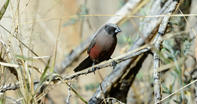
Name
Black-faced waxbill (Estrilda erythronotos)
Black-faced Waxbill Appearance
Black-faced waxbill have grey-brown heads and backs and barred wings. They have deep crimson rumps. This wax bill has a black face, with black legs and a black bill. The eye is red. Both sexes look the same.
This is a small bird at around 12 cm in length.
Black-faced Waxbill Diet
The black-faced waxbill feeds mostly on grass seeds, but will eat nectar and insects. This waxbill is very dependent on water.
Black-faced Waxbill Breeding
The black-faced waxbill is monogamous. The nest is a bulky ball-shaped grass structure, placed high in the thin uppermost branches of a tree. The female lays between two and four eggs, that hatch around 12 days later.
Black-faced Waxbill Behaviour
The black-faced waxbill is found in pairs or small groups outside of the breeding season. These waxbills feed mainly on the ground and look like they are constantly on the move.
Threats
None.
Distribution and Habitat
The black-faced waxbill main habitat is acacia thickets or thorn bushes, in semi-arid to arid savanna. This waxbill needs permanent surface water for drinking. The black-faced waxbill can be found in the Northwest, Free State and Limpopo Provinces of South Africa.